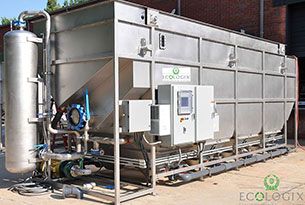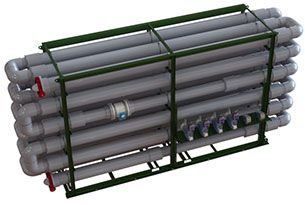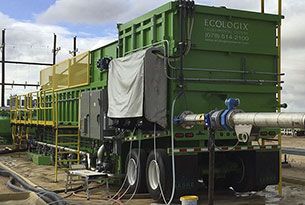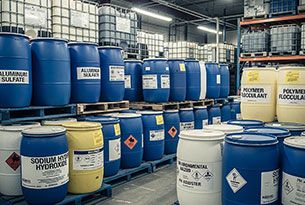Introduction to Coagulation and Flocculation in Wastewater Treatment
Industrial wastewater often contains suspended solids, oils, and other contaminants that make it challenging to meet stringent discharge regulations or reuse water effectively. At Ecologix Environmental Systems, we leverage chemical coagulation and flocculation as critical processes to enhance clarification in industrial effluent, ensuring cleaner water and compliance with environmental standards. These techniques are foundational to many of our wastewater treatment systems, such as Dissolved Air Flotation (DAF) and Integrated Bio-Reactor (IBR) solutions, and are widely used across industries like food processing, mining, and oil and gas.
Coagulation and flocculation work together to remove impurities by destabilizing particles and forming larger aggregates that can be easily separated from water. This article explores how these processes function, their benefits, and how Ecologix optimizes them for superior wastewater treatment outcomes.
Understanding Coagulation and Flocculation
Coagulation: Destabilizing Particles
Coagulation involves adding chemical coagulants to wastewater to neutralize the electrical charges on suspended particles, such as colloids, oils, and organic matter. These particles often carry a negative charge, causing them to repel each other and remain suspended. Coagulants, such as aluminum sulfate (alum), ferric chloride, or polyaluminum chloride (PAC), introduce positive ions that neutralize these charges, allowing particles to come closer together.
Flocculation: Building Larger Aggregates
Following coagulation, flocculation promotes the formation of larger, heavier particles called flocs. This is achieved by adding flocculants, typically polymers, that bridge destabilized particles together, or through gentle mixing that encourages particle collisions. The resulting flocs are easier to remove through sedimentation, filtration, or flotation processes like DAF.
Ecologix's proprietary floctubes and chemical reaction tanks are designed to maximize contact time and mixing efficiency, improving floc formation by up to 30% compared to traditional systems.
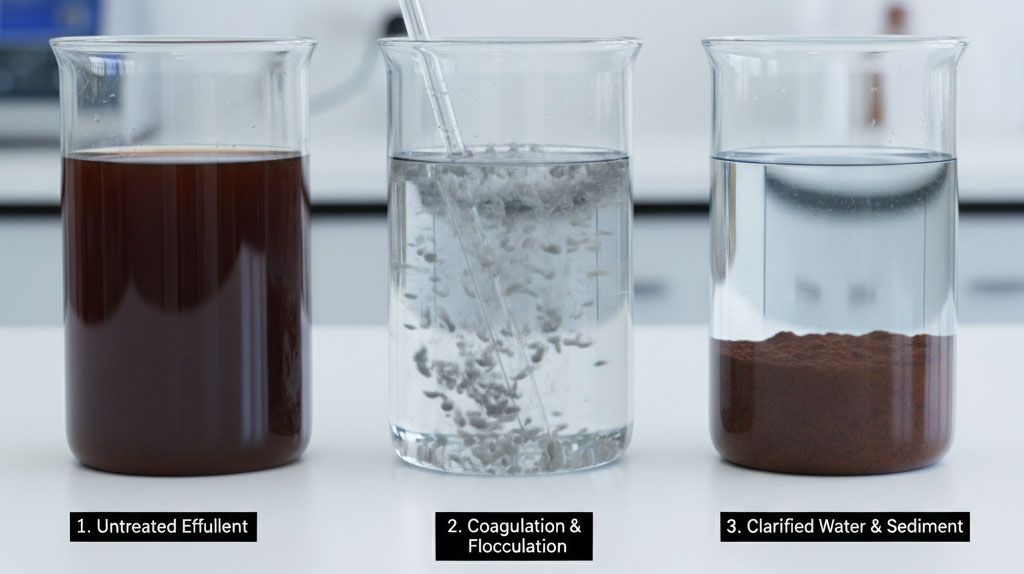
How Coagulation and Flocculation Enhance Clarification
The combined process transforms murky, contaminant-laden wastewater into clearer effluent through the following steps:
- Chemical Dosing: Coagulants are precisely dosed into the wastewater based on laboratory analysis of its characteristics, such as pH, turbidity, and pollutant load.
- Rapid Mixing: The coagulant is rapidly mixed to ensure uniform distribution and charge neutralization.
- Flocculation Stage: Flocculants are added, and slow mixing promotes the formation of large, stable flocs.
- Separation: Flocs are removed via settling (e.g., in lamella clarifiers), flotation (e.g., in DAF systems), or filtration, leaving clarified water.
This process is highly effective for removing suspended solids, heavy metals, and organic compounds, making it a cornerstone of industrial wastewater treatment.
Benefits of Coagulation and Flocculation
Implementing chemical coagulation and flocculation offers significant advantages for industrial facilities:
- High Contaminant Removal: Achieves up to 95% removal of suspended solids, oils, and greases, ensuring compliance with discharge regulations.
- Versatility Across Industries: Effective for diverse wastewater streams, from food processing (e.g., dairy or meat production) to mining (e.g., heavy metal-laden effluent) and fracking (e.g., produced water).
- Improved Downstream Processes: Clarified effluent enhances the performance of subsequent treatments, such as ultrafiltration or biological processes, by reducing load.
- Cost Efficiency: Optimized chemical dosing and compact system designs, like Ecologix's DAF units, minimize operational costs while maximizing throughput.
- Environmental Compliance: Reduces pollutants like BOD, COD, and heavy metals, helping facilities avoid fines and support sustainability goals.
Applications in Industrial Wastewater Treatment
At Ecologix Environmental Systems, we tailor coagulation and flocculation processes to meet the unique needs of various industries:
- Food and Beverage: In dairy or poultry processing, our systems handle high levels of fats, oils, and grease (FOG) using coagulants like ferric chloride, paired with DAF for efficient solids removal.
- Mining: Heavy metal removal is achieved by combining coagulants with lamella clarifiers to precipitate metals like iron or copper from wastewater.
- Oil and Gas: Our mobile Integrated Treatment Systems (ITS) use coagulation and flocculation to treat produced water from fracking, processing up to 2,000,000 gallons per day for reuse or safe discharge.
- Municipal and Industrial Ponds: Coagulation aids in phosphate removal, controlling algae blooms and clarifying water for aesthetic and ecological benefits.
Our laboratory testing services ensure precise chemical selection and dosing, optimizing performance for specific wastewater compositions.
Ecologix's Expertise in Coagulation and Flocculation Systems
Ecologix Environmental Systems designs turnkey solutions that integrate coagulation and flocculation seamlessly into wastewater treatment processes. Our offerings include:
- Custom Chemical Programs: We provide coagulants and flocculants sourced for high purity and effectiveness, such as our Australian-sourced Lanthanum Chloride for phosphate removal, ensuring no heavy metal contamination.
- Advanced Equipment: Our DAF systems, like the Model E-815, combine coagulation and flocculation with flotation for compact, high-efficiency treatment.
- Comprehensive Support: From wastewater analysis to system installation and startup, we ensure optimal performance and compliance.
For example, in a recent project for a food processing plant, Ecologix implemented a DAF system with tailored coagulant dosing, reducing suspended solids by 98% and enabling water reuse, saving the client significant disposal costs.
Challenges and Best Practices
While highly effective, coagulation and flocculation require careful management:
- Chemical Selection: Choosing the right coagulant and flocculant depends on wastewater characteristics. Overdosing can increase costs and create sludge disposal issues.
- pH Control: Coagulation is most effective within specific pH ranges (e.g., 6.5-8.5 for alum). Ecologix's systems include automated pH adjustment for consistent results.
- Sludge Management: The process generates sludge that must be handled responsibly. Our lamella clarifiers and dewatering solutions minimize sludge volume for cost-effective disposal.
Regular monitoring and jar testing, as offered by Ecologix, ensure optimal chemical performance and process efficiency.
Conclusion: Optimize Clarification with Ecologix's Solutions
Chemical coagulation and flocculation are indispensable for achieving high-quality effluent in industrial wastewater treatment. By destabilizing and aggregating contaminants, these processes enable efficient clarification, regulatory compliance, and sustainable water management. Ecologix Environmental Systems brings over 20 years of expertise to deliver customized, high-performance solutions that integrate these techniques into robust treatment systems.
Ready to enhance your wastewater clarification process?
Contact Ecologix Environmental Systems to explore our coagulation and flocculation solutions, from chemical programs to advanced DAF and clarifier systems.
Contact Our Experts Now